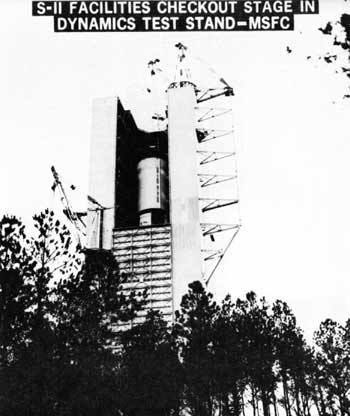.gif)
|
Man in Space
A National Historic Landmark Theme Study |

|
|
Rocket Test Facilities |

Exterior view of Saturn V Dynamic Test Stand with S-11 stage in place, 1966.
(Courtesy of NASA, NASA/Marshall Space Flight Center Facilities Office)
Saturn V Dynamic Test Stand
| Name: | Saturn V Dynamic Test Stand (Dynamic Structural Test Facility) |
| Location: | George C. Marshall Space Flight Center, Huntsville, Alabama |
| Owner: | National Aeronautic and Space Administration (NASA) |
| Condition: | Excellent, altered, original site |
| Builder/Architect: | NASA |
| Dates: | 1964-Present |
DESCRIPTION
The Dynamic Structural Test Facility was built in 1964 to conduct mechanical and vibrational tests on the fully assembled Saturn V rocket. The facility is 360 feet high and 122 feet by 98 feet at the base. It has a maximum center bay size of 74 feet by 74 feet, has a main derrick at the top of the structure capable of handling 200 tons at a 70 foot radius. The facility is connected by a cable tunnel to the East Test Area which provides instrumentation for testing. An elevator provides access to 15 of the 16 levels.
When in use the test vehicle rests on hydrodynamic supports which provide a maximum of 6 degrees of freedom of movement which is required when large space vehicles are dynamically tested. Vibration loads can be induced in the pitch, yaw, or longitudinal axis to obtain resonance frequencies and bending modes. Vertical mating procedures between stages can also be investigated and checked out.
After completion of testing for the Saturn V program the Dynamic Structural Test Facility was modified for testing the Space Shuttle. At the present time this facility is on a standby basis, but because of its unique capabilities to dynamically test large space vehicles, it will be retained for use in future NASA programs.
STATEMENT OF SIGNIFICANCE
The Dynamic Structural Test Facility is significant because of its connection with the testing and development of the Saturn V rocket.
The Saturn V rocket was one of the most reliable rockets ever built. Upon its success depended the fate of the Apollo program and the Skylab program. The success of the Saturn V was because of two factors: (1) the stringent reliability and quality assurance programs developed to oversee the manufacture of the Saturn V, and (2) exhaustive ground testing.
The ground testing program was crucial to the success of the Saturn V. Once launched a Saturn V could never be recovered for testing. Any flaw in the vehicle could result in the loss of the vehicle and the loss of the lives of the astronauts riding the Apollo Command Module.
The Saturn V had to work and perform its job successfully every time. There was no margin for error. Due to this fact as much as 50 percent of the total effort and money in the Saturn V program was devoted to ground testing the vehicle. Every component of the vehicle was tested again and again separately and in partial and full assembly.
The Dynamic Structural Test Facility at Marshall represented the last step in this testing process before a Saturn V was accepted for full flight status. Once all of the components were accepted and tested the Saturn V was assembled and brought to the Dynamic Structural Test Facility to test the entire vehicle under dynamic load conditions. Mechanical and vibrational tests on the flight vehicle and on separate flight configurations were conducted until the data indicated that the Saturn V was clean and ready for flight status. Testing conducted in this facility permitted NASA and industry engineers their last chance to detect and correct any problems or flaws in the fully assembled flight vehicle. The success of the Saturn V program and the fact that no Saturn V ever failed in flight is indicative of the contribution of this facility. Major problems capable of causing a failure of the vehicle were discovered and corrected before the Saturn V ever reached Launch Complex 39 at the Kennedy Space Center. When the Apollo 11 moon flight lifted off the pad in July 1969 the astronauts and NASA were confident that the Saturn V would complete its job and launch the Command and Lunar Landing Module into a safe moon-bound trajectory.
BIBLIOGRAPHY
Bilstein, Roger B. Stages to Saturn: A Technological History of the Apollo/Saturn Launch Vehicles. Washington, D.C.: National Aeronautics and Space Administration, 1980.
Brooks, Courtney G., Grimwood, James M. and Swenson, Loyd S. Chariots for Apollo: A History of Manned Lunar Spacecraft. Washington, D.C.: National Aeronautics and Space Administration, 1979.
Draft Historic Properties Report: Redstone Arsenal, Alabama with the George C. Marshall Space Flight Center. Silver Spring, Maryland: Building Technology Incorporated, 1983.
Master Plan George C. Marshall Space Flight Center. Washington, D.C.: National Aeronautics and Space Administration, 1980.
Technical Facilities Catalog Vol. III. Washington, D.C.: National Aeronautics and Space Administration, 1974.
PHOTOGRAPHS
(click on the above photographs for a more detailed view)
Last Modified: Mon, Jan 8 2001 10:00:00 am PDT
man-in-space/space11.htm






 Top
Top